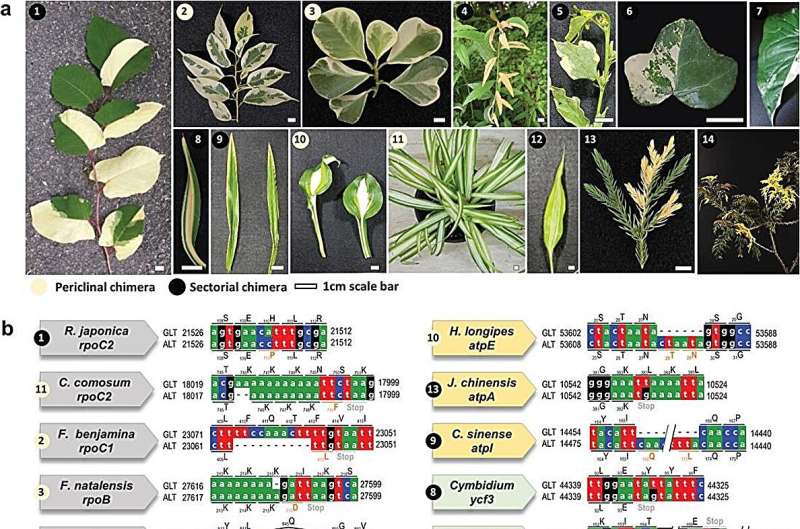This article has been reviewed according to Science X's editorial process and policies. Editors have highlighted the following attributes while ensuring the content's credibility:
fact-checked
peer-reviewed publication
trusted source
proofread
Unlocking the secrets of chimerism: Plastid genes and the quest for variegation in the ornamental plant market

The global indoor plant market is burgeoning, with projections of reaching $7.27 billion by 2025. Chimeric plants, first noted in the 17th century, have become popular for their distinctive variegated patterns. These patterns are a product of the structure and development of the plant's shoot apical meristem (SAM).
Recent studies have shown that chimeric plants, displaying both normal and albino tissues, often result from mutations in the plastome, the genetic material in chloroplasts responsible for photosynthesis. These mutations affect plastid gene transcription, regulated by two types of RNA polymerases, leading to diverse phenotypic expressions. However, the precise genetic triggers and regulation of chimerism are still unknown.
In November 2022, Horticulture Research published a perspective titled "High-throughput discovery of plastid genes causing albino phenotypes in ornamental chimeric plants."
In this study, researchers examined 23 chimeric plants from various species and reconstructed their plastomes de novo using a method involving genomic DNA sequencing of green leaf tissue (GLT) and albino leaf tissue (ALT). These results revealed a quadripartite structure in angiosperm plastomes and a lack of inverted repeats in gymnosperm plastomes. Crucially, the study found heteroplasmy in 14 out of 23 plants, with variances in plastomes derived from GLT and ALT being attributed to single point mutations.
No nuclear ribosomal DNA differences were observed between GLT and ALT. Subsequent analysis of the plastomes identified 14 independent genic mutations across eight plastid genes, and confirmed that each mutation would disrupt certain aspects of chloroplast function, leading to albino zones or leaves. Furthermore, a notable contrast emerged in the sequencing reads of wild-type and mutant plastomes between GLT and ALT, with mutations predominantly found in the ALT plastomes, suggesting a disruption in chloroplast function.
Delving into the functional implications, the RpoC2 mutation discovered in R. japonica's albino leaves was characterized. Structural analyses, using protein modeling and comparison with a bacterial RNA polymerase, indicated that the mutation likely affects the structural integrity and function of the enzyme. Transcriptional analysis confirmed the impact of this mutation, with a marked decrease in the expression of photosystem-related genes in ALT.
Further research results indicated that the photosystem cannot form correctly in ALT, and the substitution of RpoC2 His114Pro in ALT plastids may impair the correct transcription of photosynthetic genes, thereby affecting photosynthesis in albino tissues.
In conclusion, this study not only identified specific mutations linked to the albino phenotype in chimeric plants but also shed light on the significant role of these mutations in compromising the plants' photosynthetic machinery. These findings are critical and lay the foundation for future research aimed at understanding plastid biogenesis and the evolution of organellar genomes, thus potentially leading to the advancement of horticultural practices and genetic engineering for variegated plant varieties.
More information: Hyun-Seung Park et al, High-throughput discovery of plastid genes causing albino phenotypes in ornamental chimeric plants, Horticulture Research (2022). DOI: 10.1093/hr/uhac246
Journal information: Horticulture Research
Provided by NanJing Agricultural University



















